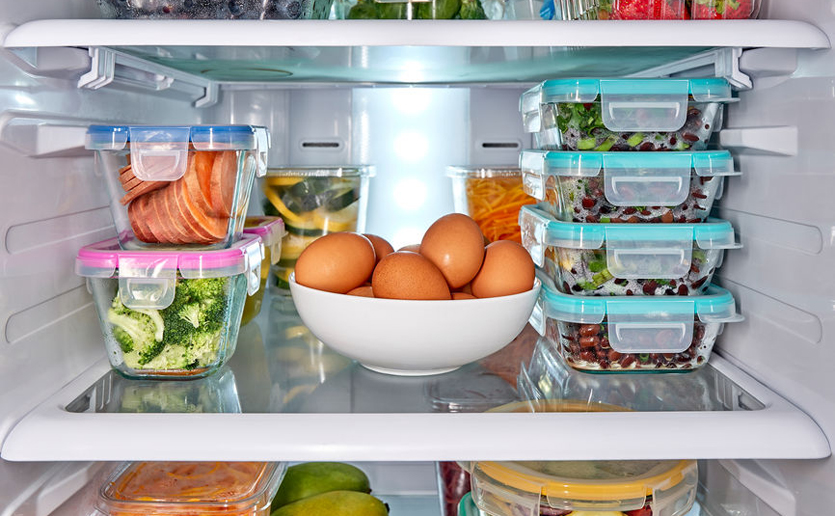Key Takeaways
Our surrounding environment is always interacting with us — it affects our diets too. The physical space where we cook can impact how we eat. If cabinets, counters and fridge shelves are cluttered, it will make healthy eating harder.

It is easy to feel overwhelmed when making diet changes, but focusing on where most food preparation is done – the kitchen – will get you on the path to a more supportive environment.
Step 1: Open Your Fridge
What do you see first?
If it is not something supportive, it’s probably time to rearrange things. Put perishable produce at eye level. Don’t keep fruits and vegetables in refrigerator drawers if you can help it. Your sad forgotten cucumbers are more likely to grow unwanted fur if you keep them out of sight.
As for the crisper? In theory, it helps control air flow, but different types of produce need different levels of humidity, and most humans don’t have the time to sort out whether spinach should go in the same drawer as their apples (turns out it shouldn’t). Keep items you won’t forget about in there. Beer or leftover chocolate cake comes to mind.
Uncooked proteins, like raw poultry, fish or eggs, go on the bottom shelf. This reduces risk of food-borne illness from cross contamination by decreasing the odds that bacteria from uncooked chicken will show up in your salad.
Lastly, if you need new food storage containers, invest in a clear glass variety. This way you can see leftovers, increasing the likelihood they’ll get eaten.
Step 2: Purge Your Cabinets
Take out anything with an expiration date that is way past due. In general, low-acid canned goods, like beans, last longer than high acid items such as tomatoes or fruits. Throw out any swollen or dented cans, as these are an invitation for botulism, a rare but serious illness. Then get rid of the items you do not like eating – they are not doing you any favors cluttering up shelves.

Step 3: Refresh Go-To Grains
Most Americans do not eat enough whole grains, often because we eat too many refined ones. Make room for options that better align with health goals. Whole wheat couscous cooks in literally five minutes. Quinoa, a gluten-free whole grain, takes as long as pasta to prepare. Both are great for making grain bowls for lunch or a quick dinner. Don’t underestimate the power of oatmeal – it’s a whole grain too.
Step 4: Disperse Your Produce
Store produce in more than one spot.
Since most of us also fall short eating adequate fruits and vegetables, scatter them around the kitchen for easy access. Keep a few pieces of fresh fruit on the counter and place what you won’t eat over the next day or two at eye level in the fridge. Stock dried apricots, plums (prunes), raisins, apples, figs or mangoes in the pantry. These options typically do not contain added sugar.
Keep flavorful canned vegetables around, like roasted red peppers, marinated artichokes, pickled green beans or beets. They can quickly perk up a salad or sandwich. (Not all canned foods are high in sodium, but if it’s a concern, look for brands with less than 10% of the daily value per serving.) Frozen fruits and vegetables are helpful to have on hand when going to the grocery store just isn’t a reality.

Step 5: Diversify Your Proteins
Stock up on healthy no-cook proteins.
You have many options to choose from, ranging from marine-based sources like canned tuna, salmon and sardines, to plant-based varieties including canned beans, peanuts and pumpkin seeds. If you don’t go through nuts and seeds quickly, keep them in the fridge. This reduces how quickly their oils turn rancid.
There are entire dinners you can make with items kept on hand. While some meals may require a stove top, the time spent there is minimal. Tuna melts and chickpea-based soups, made using premade stock and frozen spinach, come together quickly. (Flavor boosters like tomato paste, smoked paprika, hot sauce, and harissa, a spicy North African condiment, come in handy in these scenarios.) Or pick up leafy greens and assemble a no-cook antipasto salad using jarred red peppers, artichokes and tuna. Toss on beans and nuts or cheese to make the meal more filling.
Though “what you see is what you eat” isn’t really an aphorism, it should be. So declutter your kitchen and then stock it with supportive foods for fast meals.

Emily Gelsomin, MLA, RD, LDN, is a senior clinical nutrition specialist at Massachusetts General Hospital. As a registered dietitian, she counsels on medical nutrition therapy on an outpatient basis and is co-director of Be Fit, the hospital’s employee wellness program.
Jointly sponsored by The Clubs at Charles River Park and MGH Nutrition and Food Services, the 10-week program focuses on helping participants “Be Fit and Eat Right.” Every ten weeks, employees from different departments within the hospital compete with each other as they make a commitment to Be Fit. Through the creation of a social environment at the workplace, participants are supported to make progress in personal lifestyle changes with the help of a unique support system that includes a dedicated nutritionist and personal trainer.
Be Fit strives to create a milieu of wellness that extends beyond the 10-week curriculum by offering features to those who are not part of the intensive program. This includes the creation of Choose Well, Eat Well, a rating system designed to help both employees and patients increase awareness of healthy choices at retail eateries within the hospital. They also publish a timely nutrition tip each month.


